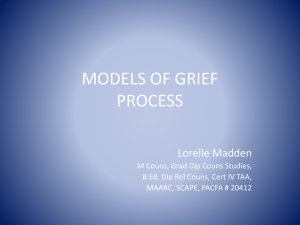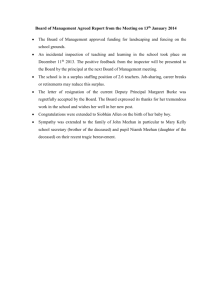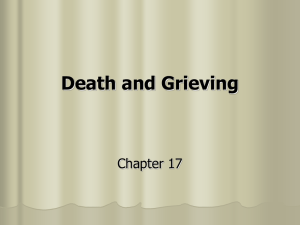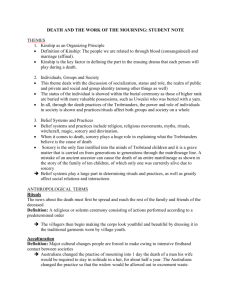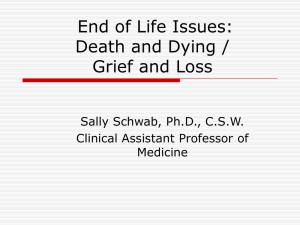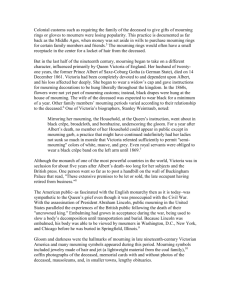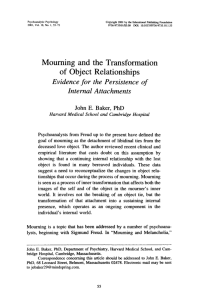abstract - Department of Sociology and Social Work
advertisement
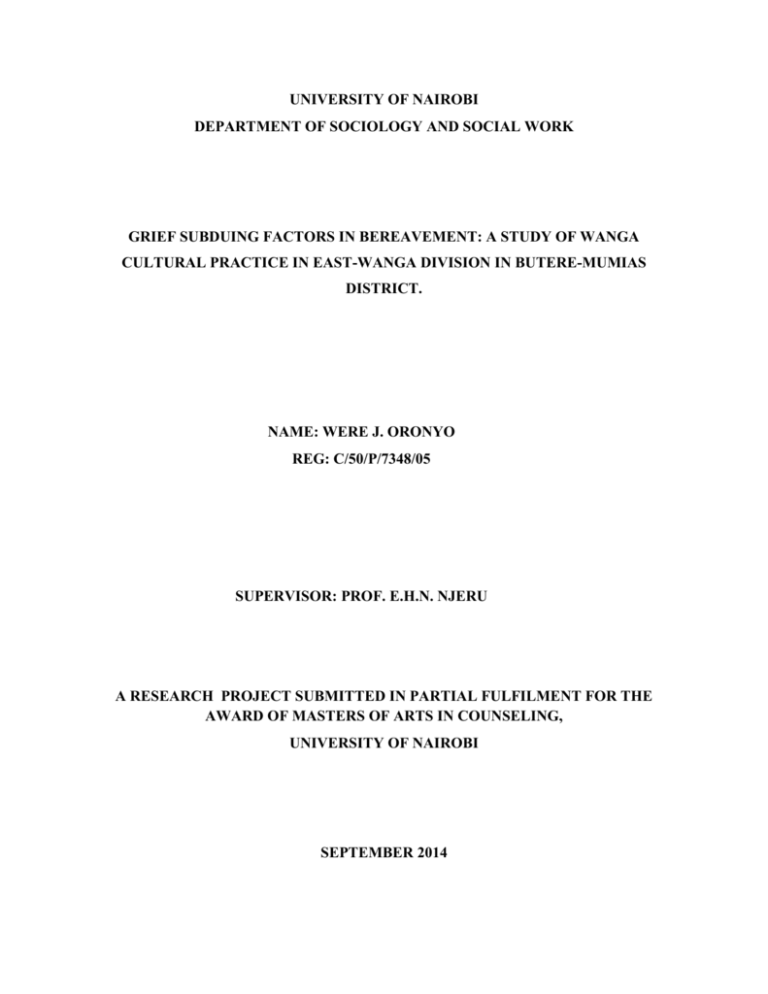
UNIVERSITY OF NAIROBI DEPARTMENT OF SOCIOLOGY AND SOCIAL WORK GRIEF SUBDUING FACTORS IN BEREAVEMENT: A STUDY OF WANGA CULTURAL PRACTICE IN EAST-WANGA DIVISION IN BUTERE-MUMIAS DISTRICT. NAME: WERE J. ORONYO REG: C/50/P/7348/05 SUPERVISOR: PROF. E.H.N. NJERU A RESEARCH PROJECT SUBMITTED IN PARTIAL FULFILMENT FOR THE AWARD OF MASTERS OF ARTS IN COUNSELING, UNIVERSITY OF NAIROBI SEPTEMBER 2014 ABSTRACT The Wanga is a community residing in Buture- Mumias district, in Western Kenya. They form part of the 42 sub-tribe in Luhya, even though they originally came from Uganda. Among the Kenyan societies, they are a community who has an elaborate culture towards funerals and the bereaved. Grief is the emotion people feel when they experience a loss which results when our important relationships are significantly interrupted or (more frequently) ended, either through death, divorce, relocation, theft, destruction, or some similar process. There is always more effort in the arrangements for the burial of the dead than in dealing with grief for the bereaved. Apart from the immediate consolation of the bereaved, little or nothing is done before death strikes. After the funeral the bereaved family is left by themselves, but experience has revealed that this could be a very traumatizing period. Trauma arises because most people are inept at dealing with grief. This occurs despite the fact that most communities have cultural practices and mourning rituals observed in death. The significance of these rituals is however losing value because the meanings attached to them have not been clarified and thus gradually being eroded The challenge then is to take another look at these mourning rituals. The Luhya as a community continue to be so engrossed in the cultural practices upon the death of their own. Some cultural practices have turned out to be in conflict with the same traditions or with the previously mentioned neo-societal trends, thus undermining positive aspects of those customs. It is worth noting here that death comes with many interpretations. These are followed by several practices and ceremonies - the value of which may have been well meant in the past. However some of them could be seen to have lost ground or are overemphasized with misinterpretation from earlier intended purposes, thus losing meaning. The issues raised here, including that of material capacity to deal with death, need to be reconciled with the cultural practices in mourning – specific to the Wanga community. If there are bereavement traditions which indeed alleviate the grieving process then these should be emphasized. Currently, professional/scientific means like counselling exist to deal with grief. Such services are however rare or not known because of scarcity of professionals. Besides, they are costly to obtain or lack awareness within the communities at grassroots level. The familiar traditional mourning customs if re-evaluated and preserved could help to deal with the grief problem. There is need to study, identify and isolate those cultural elements that provide solace in mourning to compliment in grief therapy. The familiar traditional mourning customs if re-evaluated and preserved could help to deal with the grief problem. There is need to study, identify and isolate those cultural elements that provide solace in mourning to compliment in grief therapy. The studies have been looking into common Luhya cultural activities at bereavement and the meaning that are attached to the different activities. Further on it look into what extent the mourning rituals serve to deal with the grieving process. Objectively the studies tried to understand the nature and role of Luhya mourning rituals in mitigating grief in bereavement. Particularly, it focuses on identifying the common Luhya cultural activities associated with bereavement, understand the meaning and functions of bereavement rituals, and establish the manifestation of therapeutic aspects of bereavement rituals. The study was meant to give exposure of the Luhya cultural practices and values in mourning and bereavement. The results could be correlated to provide generalizations on the population or attract studies to other specific communities. These are meant to influence solutions to the problem of grief and long term strategies to alleviate the same from stakeholders and other concerned parties. Eventually it is envisaged that the approach could trigger anthropological initiatives to conserve beneficial cultural practices. The study was keen on identifying the feelings expressed in grieving, how the emotions affect the grieving persons and how the cultural elements availed in mourning customs deals with grief process. It was also within the interest of this research to extract the beliefs, functions, meanings, of the identified bereavement rituals and then relate these with the contemporary therapeutic models. This was an exploratory study in nature attempting to gain familiarity with the phenomena under study through discovery of new ideas. It was designed mainly using qualitative method approach that study knowledge on psychosocial implications attached to grief and bereavement rituals. It interpreted and came up with inferences from the cultural practices in mourning from the Luhya in Mumias The study was carried out in Shibinga location, East Wanga division of Mumias district, one of the districts of western province of Kenya. The location lies adjacent to Mumias town, the administrative and economic centre of the district, and many people who work or carry out trade in town. The location has five sub-locations namely Shibinga, Mung’ang’a, Lubinu, Lusheya and Eluche The unit of observation in this study includes the bereaved persons, relatives and friends. The informants are the council elders, chiefs, professional mourners, professional counselor, district officer in-charge of registration of birth and death , religious and spiritual leaders This study used multiple sources of information, both primary and secondary (known as triangulation) to ensure validity and reliability of data collected. The study used non-probability technique because there was no sample frame in existence for whole population and death and bereavement were unpredictable in the five sub-locations. The five sub-locations formed the strata from which sample of respondents were chosen through the use of the three non-probability technique that were suitable to the area under study namely purposive, accidental and snowballing. The total sample consisted of twenty five respondents and twenty five informants. The study had employed a combination of qualitative field–based methods of data collection both in primary and secondary. The key informants were council elders, chiefs, professional mourners, professional counselor, district officer in-charge of registration of birth and death , religious and spiritual leaders. In the data presentation, the study made various observations. As soon as death strikes, wailing will rend into the air, in case it is man who has died, then crying would be repeated four times simultaneously, while for a woman will be three times. A widow is expected as soon as the death of the husband is announced , to go back to the parents home to inform them about the death. Grieving and mourning period is a solemn period, that most activities would cease to take place even the house would not be swept. Activities such a cultivating land or going for work, would all be suspended for any of the family members. All these are symbols of being in solidarity with the deceased spirit. During the first evening of death, fire called ‘amachenga" will be lit outside the deceased home. Mourning time, it is a grave moment and non of the men family members is expected to sleep in a house, they are suppose to keep vigil while warming themselves. It is believed that the spirit of the dead is hovering around the compound as well warming itself until it is ritually sent off, and if nobody will be there it will disturb the entire community. Death is a solemn moment, and the importance given to the rituals would depend on various attributes of the deceased person. Death of somebody with such prominence as king and others like medicine men or a rainmaker becomes the concern of the entire community. Everybody within that whole society is expected to mourn and grieve as well as to participate in the burial rituals. The older the person the more the importance is given, through the numbers of days for mourning, the bigger the celebrations and attendance of the relatives and friends. Gender and marital status are among some factors that matters. When a married man and has dies, he would be buried at the right side of his house. The right side symbolizes strength and it is where he as leader watches over the home. A married woman and with children when she dies would be buried to the left side of the husband’s grave. The left side is an assumed position of a married couple when making love. When unmarried childless man or woman 'omusumba' dies, the body has to be pierced through the ears and foot. If a woman was married then divorced or separated then dies, the customs demands that she must be buried at the former husband’s homestead. Cause of death is a factor that would be scrutinized so to know the kind of a send off rituals the deceased would be accorded. Self inflicted death, is greatly abhorred and it is such an embarrassed to the deceased family. For instance if a person had committed suicide either by hanging or drowning one self, some cleansing ceremonies have to be performed to the people who witnessed that kind of death and the deceased would be buried at night, while there would be no mourning. Having taken into consideration all the necessary factors then, the expected rituals would expected to follow suit. The body will be bought into the house, left there for viewing until the time of the burial. These is to enable the bereaved to come to term with the reality that the beloved person is dead, thus bidding farewell to the deceased. This marks the key right of separation. There is the giving of the gift, a symbol of expiation to show that the bereaved family is exempted from having anything to do with death of that person. It is also a kind of traditional license that allows them to go on with the burial. There is the act of sharing of meal in the funeral. Eating at the funeral is one of the important aspects of the entire grieving period. In the first place it a sign of sharing grieve with the bereaved and it is considered as the last meal with the deceased. It is an indication to show that one is innocent as far as the death is concerned and he or she had no malice towards the bereaved. Among some burial rites is one is when a cow or a bull has to be selected for the occasion. Two community leaders will be chosen to perform the rituals. One will waive the spear to the animal, and the other person would drive the animal towards the corpse by pulling the rope. When the animal reaches at the door step, it will be speared while the other people hits the head until it dies. The hide would be used for wrapping the dead. It is now that the body would be ready for the burial. There will be the late afternoon burial signifies that life is going down the way the sun set in the evening. It is only those people who died in disgraceful ways such as suicide or murder that are buried either at night or before noon. According to the Wanga legendary, they say that the ancestors of these community originated from the Western side. During the burial it is expected that when during the head should face towards the West, so that they should join the ancestors. After the burial, a chicken will be burn at the graveside, so that those children born and named after the deceased will not be haunted by his or her spirit. An old respected man would be given a hero send off by organizing a bull fight at the grave side. On the third day, it is the time where all the nuclear members of the given family are supposed to be shaved. This signifies the aspect of cleansing oneself and getting detached from any bad omen. Normally the shaving is done by the deceased sister at the grave side. After forty days after death of the deceased, all the relatives are expected come for the commemoration of the deceased. Much will be said about the decease, what he or she was, what she wanted and hope to do. It is at this time where the will of the decease will be announced and members of the family would be instructed on what to do next. A special commemoration celebrations for a senior member of the society would held one year after the death. The day will be marked with celebrations by eating, dancing and drinking so as to celebrate the life of the deceased.
